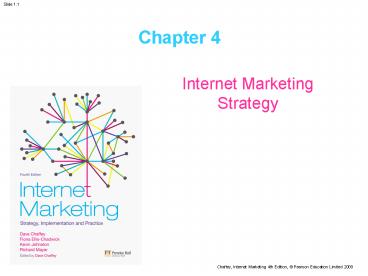Internet Marketing Strategy PowerPoint PPT Presentation
1 / 26
Title: Internet Marketing Strategy
1
Chapter 4
- Internet Marketing Strategy
2
Michael Porter on the Internet
- The key question is not whether to deploy
Internet technology companies have no choice if
they want to stay competitive but how to deploy
it.
Porter, M. (2001) Strategy and the Internet,
Harvard Business Review, March 2001, 6278.
3
What is an E-marketing strategy?
- What is strategy?
- Defines how we will meet our objectives
- Sets allocation of resources to meet goals
- Selects preferred strategic options to compete
within a market - Provides a long-term plan for the development of
the organisation
4
E-marketing strategy essentials
- E-marketing strategy is a channel strategy
- Objectives for online contribution - sales,
service, profitability should drive our strategy - E-marketing strategy defines how we should
- Communicate benefits of using this channel
- Prioritise audiences targeted through channel
- Prioritise products available through channel
- Hit our channel leads sales targets
- Acquisition, Conversion, Retention
- Channel strategies thrives on differentials
- BUT, need to manage channel integration
5
Figure 4.1 Internal and external influences on
Internet marketing strategy
6
(No Transcript)
7
(No Transcript)
8
Figure 4.2 Hierarchy of organisation plans
including e-marketing plans
9
Problems if no E-marketing strategy
- 1 Underestimated demand for online services
- 2 Market share loss
- 3 Resource duplication
- 4 Insufficient resource
- 5 Insufficient customer data
- 6 Efficiencies available through online marketing
- 7 Opportunities for applying online marketing
tols - 8 Changes required to internal IT systems
- 9 Inadequate tracking
- 10 Senior management support limited
10
Figure 4.3 Usage of detailed e-marketing plans
in UK e-commerce organisationsSource
EConsultancy (2008)
11
Figure 4.4 The SOSTAC planning framework
applied to digital Internet marketing strategy
developmentSource Chaffey and Smith (2008)
12
Figure 4.5 Dynamic e-business strategy
modelSource Adapted from description in
Kalakota and Robinson (2000)
13
Figure 4.6 Levels of website development in (a)
the information to transaction model and (b) the
transaction to information model of Quelch and
Klein (1996)
14
Figure 4.7 A generic Internet-specific SWOT
analysis showing typical opportunitiesand
threats presented by the Internet
15
Figure 4.10 Grid of product suitability against
market adoption for transactionale-commerce
(online purchases)
16
Internet marketing benefits
- Intangible benefits
- Corporate image communication
- Enhance brand
- More rapid, more responsive marketing
communications including PR - Improved customer service
- Learning for the future
- Meeting customer expectations
- Identify new partners, support existing partners
- Better management of marketing information and
customer information - Feedback from customers on products
- Tangible benefits
- Increased sales from new sales leads giving rise
to increased revenue from - new customers, new markets
- existing customers (repeat-selling)
- existing customers (cross-selling)
- Cost reductions from
- reduced time in customer service
- online sales
- reduced printing and distribution costs of
marcomms
17
Figure 4.10 Grid of product suitability against
market adoption for transactionale-commerce
(online purchases)
18
Figure 4.12 Using the Internet to support
different organisational growth strategies
19
Figure 4.15 Stages in target marketing strategy
development
20
Common online targeting options
- Brand loyalists convert online
- Not brand loyal encourage trial
- Most profitable deepen relationships
- Larger companies (B2B)
- Smaller companies(B2B)
- Key members of the buying unit (B2B)
- Difficult to reach using other media
21
Figure 4.17 Customer lifecycle segmentation
22
Figure 4.23 Strategic options for a company in
relation to the importance of the Internet as a
channel
23
Figure 4.24 Flow chart for deciding on the
significance of the Internet to a
businessSource After Kumar (1999)
24
Figure 4.25 Channel coverage map showing the
companys preferred strategy for communications
with different customer segments with different
value
25
Figure 4.27 Summary of alternative
organisational structures for e-commerce
suggested in Parsons et al. (1996)
26
Figure 4.30 Example of riskreward analysis

